Platinum coin

Platinum coins are a form of currency. Platinum has an international currency symbol under ISO 4217 of XPT. The issues of legitimate platinum coins were initiated by Spain in Spanish-colonized America in the 18th century and continued by the Russian Empire in the 19th century. As a form of currency, these coins proved to be impractical: platinum resembles many less expensive metals, and, unlike the more malleable and ductile silver and gold, it is very difficult to work. Several commemorative coin sets have been issued starting from 1978 and became popular among coin collectors. The major platinum bullion coins include the American Platinum Eagle, the Canadian Platinum Maple Leaf, the Australian Platinum Koala, the Isle of Man Noble, the Chinese Platinum Panda and several series by the Soviet Union and later by the Russian Federation. The production of most platinum coins stopped around 2005 except for the American Platinum Eagle – one of the world's most popular platinum coins – which was still being produced in 2009.
History
Platinum was first used for minting coins in Spanish-colonized America. Following the discovery of platinum in gold rocks, the Spaniards were unable to use it for a long time because they had no technology for processing this metal. The then-cheap platinum was used for various kinds of frauds, such as substituting it for the more expensive silver. After the discovery that platinum alloys with gold, counterfeiters began to add it to gold coins. The platinum confiscated from counterfeiters was then thrown into the sea, in accordance with the royal decree of 1735. Later, the practice of adding platinum to gold as a ligature was adopted by the authorities in Spain in order to lower the gold content of coins.[1] Also in Spain, in the mid-19th century, counterfeiters began producing British Sovereigns out of a gold-plated alloy of platinum and copper, relying on a similar specific weight of platinum and gold.[2]
In the late 1820s, the British Royal Mint produced several trial coins as part of experiments on the use of platinum in coins. One of these coins has the same diameter as a farthing and a weak relief owing to the high hardness of platinum. The 1812 Pattern 9 Pence Bank Token (S3773A) was used for the obverse and the farthing of 1825 for the reverse parts of this coin. No dies were manufactured for these experiments, so expired dies of the corresponding coins were used instead. Coins minted using dies from two different coins are called mules. The coin bears the year of 1825, but was likely printed at a later date. Like all test coins, the platinum farthing has a high historic and numismatic value. This coin is also interesting because it features the portrait of the already deceased monarch George III (1738–1820).[3]
The first and only case when platinum coins were used as a regular national currency[4] was in Russia, where coins were circulated between 1828 and 1845. These coins proved to be impractical: platinum resembles many less expensive metals, and, unlike the more malleable and ductile silver and gold, it is very difficult to work. However, merchants valued platinum coins because it did not melt in fires like gold or silver.[5] The minting of platinum coins resumed only after 130 years. Between 1977 and 1980, in preparation for the 1980 Summer Olympics, the Soviet Union produced five commemorative coin sets, and since 1988 commemorative platinum coins were issued every year. The practice of regularly issuing platinum coins has continued in modern Russia, and since 1992 the Central Bank of Russia has released 16 sets of platinum coins.[6]
Since 1983, other countries have begun regular minting of platinum coins.[7] The most notable examples are the Platinum cat,[8] and Platinum Noble by the Isle of Man, Canadian Platinum Maple Leaf,[9] Chinese Platinum Panda and Australian Platinum Koala. Since 1997, the hundred-dollar American Platinum Eagle became the most notable platinum coin among the collectors, named for the Bald Eagle depicted on the coin.[10]
Imperial Russia
| Platinum coins of Imperial Russia | ||
|---|---|---|
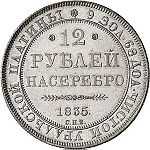 | 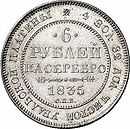 |  |
 | 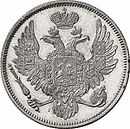 |  |
| Date of the issuing decree[11] | ||
| 12 September 1830 | 30 November 1829 | 24 April 1828 |
| Weight, g[12] | ||
| 41.41 | 20.71 | 10.35 |
A "new Siberian metal", platinum, became known in Russia in 1819. Though it was first observed only as minor inclusions in rocks, richer deposits were discovered in the late 1824 which were mined beginning in 1825.[13] These discoveries prompted Demidov to start looking for platinum around his Nizhny Tagil plants, where it was quickly found along the river beds. In late 1826, P. G. Sobolevsky (the father of powder metallurgy in Russia) invented a simple way of processing platinum that prompted the idea to use platinum in coins. The decree of 24 April 1828 noted that "among the treasures of the Ural Mountains also occurs platinum, which priorly was located almost exclusively in South America. For easy sale of this precious metal, it is desirable to introduce it in coins" and also described the design of new coins.[13]
Minting began with 3-ruble coins, and 6-ruble and 12-ruble coins were added in 1829 and 1830, respectively.[14] 1,371,691 3-ruble coins were minted, along with 14,847 6-ruble and 3,474 12-ruble coins.[13] The first coin was sent to the prominent German scientist Alexander von Humboldt, who was previously asked to evaluate the use of platinum as a currency and confirm its price relative to silver. After his death, the emperor Alexander II bought that coin, and in 1859 it was returned to Russia and later became an exhibit of the Hermitage Museum in Saint Petersburg.[4]
Minters used the same forms for the platinum and traditional silver coins, but platinum is twice as heavy as silver,[15] and it was approximately 6 times more expensive than silver at the time. The platinum three ruble coin had the same size as the silver 25 kopek (0.25 ruble) coin; it weighed twice as much and was thus valued 12 times higher. For this reason, the coin is specifically marked as "3 rubles per silver" (Russian: 3 рубля на серебро). The same reasoning applied to the 6- and 12-ruble coins. The coins were minted from native Ural platinum. It was not free from such noble metals as iridium and palladium, and thus the accompanying phrase "pure Ural platinum" (Russian: чистой уральской платины) only meant that no metal was intentionally added in production.[16]
The minting was discontinued on 22 June 1845 because of the concerns about possible financial imbalance due to the declining price of platinum; within the next 6 months, platinum coins were withdrawn from circulation. An estimated 883,212 rubles were then in the hands of the population.[13] Platinum coins then were considered neither an investment nor collectible item and were readily exchanged to the "more reliable" gold.[17]
| Year | 12-ruble | 6-ruble | 3-ruble | Total |
|---|---|---|---|---|
| 1828 | - | - | 60069 | 60069 |
| 1829 | - | 4968 | 130347 | 135315 |
| 1830 | 1428 | 51660 | 318078 | 371166 |
| 1831 | 17556 | 16704 | 259500 | 293760 |
| 1832 | 13224 | 9012 | 197301 | 219537 |
| 1833 | 3060 | 1812 | 253620 | 258492 |
| 1834 | 132 | 66 | 272916 | 273114 |
| 1835 | 1524 | 642 | 415512 | 417678 |
| 1836 | 132 | 66 | 131256 | 131454 |
| 1837 | 636 | 1518 | 138909 | 141063 |
| 1838 | 144 | 72 | 145536 | 145752 |
| 1839 | 24 | 12 | 6 | 42 |
| 1840 | 12 | 6 | 3 | 21 |
| 1841 | 900 | 1020 | 50763 | 52683 |
| 1842 | 1380 | 726 | 436734 | 438840 |
| 1843 | 1464 | 762 | 517005 | 519231 |
| 1844 | 48 | 24 | 643512 | 643584 |
| 1845 | 24 | 12 | 15006 | 15042 |
| Total: | 41,688 | 89,082 | 4,121,073[lower-alpha 1] | 4,251,843 |
The 11–32 tonnes of platinum, raw and in coins, that had accumulated at the St. Petersburg Mint by 1846 was sold to the British firm Johnson, Matte & Co. This sale made Britain a platinum monopolist even though it did not produce platinum domestically[19] Russia and Colombia were the only major platinum producers. Other possible reasons for discontinuing the platinum mint were low popularity among the population and the high cost of minting, which was 98 kopeks per 3-ruble coin as compared to less than 1 kopek per gold ruble.[13]
There were fruitless attempts to resume the platinum mint in 1859, which resulted in a scientific study on the usage of platinum in coins by academician Moritz von Jacobi, published in 1860. No country had used platinum for money after 1846, and one reason for that could be that platinum was about 2.5 times cheaper than gold in the 19th century. Currently, the platinum coins of the Russian Empire are rare, especially for the period from 1839–1840 when only a few coins were minted. All platinum coins minted in 1840 were bought by the famous numismatist Earl Ivan Ivanovich Tolstoy directly from the Saint Petersburg Mint;[16] on the numismatic auction of the United Bank of Switzerland (UBS Gold and Silver Auction 50) held in autumn 2001 in Basel, one of the two 12-ruble coins minted in 1839 was sold for US$60,500 (with a starting price of $22,000).[16]
Commemorative coins of the USSR and Russia
Eleven commemorative platinum coins with a 150-ruble face value were produced in the Soviet Union between 1977 and 1991. The first 5-coin set was dedicated to the Moscow Olympics in 1980 and was a part of a large minting which included various copper-nickel coins (8.5 million pcs.), fourteen silver coins of 5 and 10 rubles (16.67 and 33.3 g respectively) and six 100-ruble gold coins (17.3 g).[20] These "XXII Summer Olympic Games" platinum coins depicted the emblem of the Olympics and fragments of the ancient Olympic Games, and were issued in the period 1977–1980 in the two versions, proof and uncirculated. The proof minting technique (coins with mirrored background and frosted image) was first introduced in the Soviet Union in 1977 specifically for the Olympic commemorative series, and its quality (especially of the snow-like images) has been praised by experts.[21]
| Olympics-1980: Emblem of the games | |||||||||
|---|---|---|---|---|---|---|---|---|---|
| Year | Value | Grading | Purity | Weight, g | Diameter, mm | # (proof), pcs.[lower-alpha 2] | # (uncirculated), pcs. | Obverse | Reverse |
| 1977 | 150 rubles | Proof/AC | 999/1000 | 15.57 | 28.6 | 24,160 | 9,910 | ||
| Obverse: Coat of Arms of the USSR and the face value
Reverse: Emblem of the XXII Olympic Games with a laurel wreath. Bottom – minting year, left – trade mark of the mint, along the rim: "The Games of the XXII Olympiad. MOSCOW. 1980" Design: Ermakov Mint: Leningrad Mint (LMD).[22] |
 |  | |||||||
| Olympics-80: Discus Thrower | |||||||||
| Year | Value | Grading | Purity | Weight, g | Diameter, mm | # (proof), pcs. | # (uncirculated), pcs. | Obverse | Reverse |
| 1978 | 150 rubles | Proof/AC | 999/1000 | 15.57 | 28.6 | 19,853 | 13,403 | ||
| Obverse: Coat of Arms of the USSR and the face value
Reverse: Discus thrower, below – the mint trademark and the minting year, right – emblem of the games, along the rim: "The Games of the XXII Olympiad. MOSCOW. 1980" Design: Ermakov Mint: Leningrad Mint (LMD).[23] |
 |  | |||||||
| Olympics-80: Champions | |||||||||
| Year | Value | Grading | Purity | Weight, g | Diameter, mm | # (proof), pcs. | # (uncirculated), pcs. | Obverse | Reverse |
| 1979 | 150 rubles | Proof/AC | 999/1000 | 15.57 | 28.6 | 13,578 | 18,978 | ||
| Obverse: Coat of Arms of the USSR and the face value
Reverse: Two wrestlers on the backdrop of ancient columns. Between the columns – the emblem of games, under the left column – the trade mark of the mint, bottom – the minting year, along the rim: "The Games of the XXII Olympiad. MOSCOW. 1980" Design: Ermakov Mint: Leningrad Mint (LMD).[24] |
 |  | |||||||
| Olympics-80: Quadriga | |||||||||
| Year | Value | Grading | Purity | Weight, g | Diameter, mm | Circulation (proof), pc. | # (uncirculated), pcs. | Obverse | Reverse |
| 1979 | 150 rubles | Proof/AC | 999/1000 | 15.57 | 28.6 | 17,078 | 9,728 | ||
| Obverse: Coat of Arms of the USSR and the face value
Reverse: Two chariots, left – the emblem of games, bottom – the mint trademark and the minting year, along the rim: "The Games of the XXII Olympiad. MOSCOW. 1980" Design: Ermakov Mint: Leningrad Mint (LMD).[25] |
 |  | |||||||
| Olympics-80: Runners | |||||||||
| Year | Value | Grading | Purity | Weight, g | Diameter, mm | Circulation (proof), pc. | # (uncirculated), pcs. | Obverse | Reverse |
| 1980 | 150 rubles | Proof/AC | 999/1000 | 15.57 | 28.6 | 12,870 | 7,820 | ||
| Obverse: Coat of Arms of the USSR and the face value
Reverse: Two ancient runners, right – the emblem of games, bottom – the mint trademark and the minting year, along the rim: "The Games of the XXII Olympiad. MOSCOW. 1980" Design: Ermakov Mint: Leningrad Mint (LMD).[26] |
 |  | |||||||
Despite the large circulation of the Olympic platinum coins (about 20,000, compared with 750 pcs. for the 1993 series "Russian Ballet"), they are difficult to find at the Russian numismatic markets. This is mostly because of the level of export to America, Europe, and Israel.[20] Since 1977, the commemorative platinum coins have been issued every year, but designs unrelated to the Olympics appeared only on 13 September 1988, with the series "1000 years of ancient coinage, literature, architecture and the Baptism of Russia." The series consisted of two silver coins (3-ruble, "Saint Sophia Cathedral in Kiev" and "Srebrenic of Vladimir"), two gold coins (50-ruble "Saint Sophia Cathedral in Novgorod" and 100-ruble "Zlatnik of Vladimir"), the 25-ruble palladium coin "Monument to Prince Vladimir Svyatoslavich", and the 150-ruble platinum coin "The Tale of Igor's Campaign". This series was the first time palladium was used for minting coins. This series was highly praised internationally and awarded the first prize for the quality of minting at the 1988 numismatic exhibition in Basel.[21]
| Series: 1000 years of coinage, literature, architecture, and the Baptism of Russia. The Tale of Igor's Campaign | ||||||||
|---|---|---|---|---|---|---|---|---|
| Year | Value | Grading | Purity | Weight, g | Diameter, mm | # pcs.[lower-alpha 3]</ref> | Obverse | Reverse |
| 1988 | 150 rubles | Proof | 999/1000 | 15.57 | 28.6 | 16,000 | ||
| Obverse: Coat of Arms of the USSR and the face value
Reverse: An scribe at work with cavalry troops in the background. Bottom: "The Tale of Igor's Campaign · 1185", along the rim: "1000 years of ancient literature" Design: A.V. Baklanov Mint: Leningrad Mint (LMD).[27] |
 |  | ||||||
| Series: 500 years of united Russian state. Standing on the Ugra | ||||||||
| Year | Value | Grading | Purity | Weight, g | Diameter, mm | # pcs. | Obverse | Reverse |
| 1989 | 150 rubles | Proof | 999/1000 | 15.57 | 28.6 | 16,000 | ||
| Obverse: Coat of Arms of the USSR and the face value
Reverse: Two cavalry forces facing each other with the river between them, around the image: "500 years of united Russian state", bottom: "Standing on the Ugra · 1480" Design: A.V. Baklanov Mint: Leningrad Mint (LMD).[28] |
 |  | ||||||
| Series: 500 years of united Russian state. Battle of Poltava | ||||||||
| Year | Value | Grading | Purity | Weight, g | Diameter, mm | # pcs. | Obverse | Reverse |
| 1990 | 150 rubles | Proof | 999/1000 | 15.57 | 28.6 | 16,000 | ||
| Obverse: Coat of Arms of the USSR and the face value
Reverse: Russian cavalry charging at the Swedish troops, around the image: "500 years of united Russia", bottom: "Battle of Poltava 1709" Design: A.V. Baklanov Mint: Leningrad Mint (LMD).[29] |
 |  | ||||||
| Series: 250 years of discovery of Russian America. St. Gabriel | ||||||||
| Year | Value | Grading | Purity | Weight, g | Diameter, mm | # pcs. | Obverse | Reverse |
| 1990 | 150 rubles | Proof | 999/1000 | 15.57 | 28.6 | 6,500 | ||
| Obverse: Coat of Arms of the USSR and the face value
Reverse: Sailing boat in wavy sea, around: "250 years of the discovery of Russian America", bottom: "BOT St. GAVRIIL/M. GVOZDEV – 1732", divided decorative element. Design: A.V. Baklanov Mint: Leningrad Mint (LMD).[30] |
 |  | ||||||
| Series: 500 years of united Russia. War of 1812 | ||||||||
| Year | Value | Grading | Purity | Weight, g | Diameter, mm | # pcs. | Obverse | Reverse |
| 1991 | 150 rubles | Proof | 999/1000 | 15.57 | 28.6 | 16,000 | ||
| Obverse: Coat of Arms of the USSR and the face value
Reverse: An obelisk with an angel holding a cross, left – portrait of Napoleon, right – portrait of Alexander I (with names under both portraits), around the image: "500 YEARS OF UNITED RUSSIA", below: "PATRIOTIC WAR OF 1812." Design: A.V. Baklanov Mint: Leningrad Mint (LMD).[31] |
 |  | ||||||
| Series: 250-anniversary of the discovery of Russian America. John Benjamin | ||||||||
| Year | Value | Grading | Purity | Weight, g | Diameter, mm | # pcs. | Obverse | Reverse |
| 1991 | 150 rubles | Proof | 999/1000 | 15.57 | 28.6 | 6,500 | ||
| Obverse: Coat of Arms of the USSR and the face value
Reverse: The image of Ivan Veniaminov, in monk's dress, holding a cross, with a sailing boat in the background. Around it: "250 years of the discovery of Russian America", below: "Ivan Veniaminov – missionary and educator" Design: A.V. Baklanov Mint: Leningrad Mint (LMD).[32] |
 |  | ||||||
The price for platinum coins of the USSR (proof quality) typically exceeds $1,500 per coin.[33]
Russia issued 16 platinum coins starting from 1992, with the face value (weight) of 25 (1/10 oz), 50 (1/4 oz) and 150 rubles (1/2 oz).[34] Minting was suspended in 1996, with the last coin of 150 rubles dedicated to the 1240 Battle of the Neva.[16]
| Series: The Age of Enlightenment. 18th Century. Battle of Chesma | |||||||||
|---|---|---|---|---|---|---|---|---|---|
| Date | Catalogue # | Value | Grading | Purity | Total weight, g | Platinum contents, at least, g | Diameter, mm | Thickness, mm | # pcs. |
| 24 November 1992 | 5318-0001 | 150 rubles | Proof | 999/1000 | 15.67 (± 0.11) | 15.55 | 28.60 (−0.25) | 1.5 (± 0.2) | 3000 |
| Obverse: two-headed eagle (designed by I. Bilibin), bottom – BANK OF RUSSIA. At the bottom – the designation of metal, alloy, the precious metal content and the mint trademark.
Reverse: three sailing ships and a boat at the Battle of Chesma, around: "Age of Enlightenment. 18th century.", bottom: "Battle of Chesma" Design: A.V. Baklanov Mint: Leningrad Mint (LMD). 240 indents on the rim.[35] |
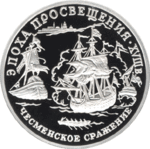 | ||||||||
| Series: The Olympic Century Russia. First participation of Russia in the Olympics | |||||||||
| Date | Catalogue # | Value | Grading | Purity | Total weight, g | Platinum contents, at least, g | Diameter, mm | Thickness, mm | # pcs. |
| 20 January 1993 | 5316-0001 | 50 rubles | Proof | 999/1000 | 7.88 (± 0.09) | 7.78 | 20.0 (−0.15) | 1.60 (± 0.15) | 7500 |
| Obverse: center – the emblem of the Bank of Russia (two-headed eagle designed by I. Bilibin), bottom – symbol, purity and weight of platinum, "BANK OF RUSSIA"
Reverse: two horse riders – Russian participants of the II Olympic Games, right – the Eiffel Tower, left – the emblem of the Russian Olympic Committee, around: "OLYMPIC AGE OF RUSSIA, FIRST PARTICIPANCE · PARIS" Design: A.V. Baklanov (obverse), N.A. Nosov (reverse) Mint: Leningrad Mint (LMD). 134 indents on the rim.[36] |
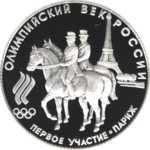 | ||||||||
| Series: Russian Ballet (25 rubles) | |||||||||
| Date | Catalogue # | Value | Grading | Purity | Total weight, g | Platinum contents, at least, g | Diameter, mm | Thickness, mm | # pcs. |
| 19 April 1993 | 5315-0001 | 25 rubles | Proof | 999/1000 | 3.198 (± 0.08) | 3.11 | 16.0 (−0.1) | 1.00 (± 0.15) | 750 |
| Obverse: center – the emblem of the Bank of Russia (two-headed eagle designed by I. Bilibin), bottom – symbol, purity and weight of platinum, "BANK OF RUSSIA"
Reverse: a dancing ballerina, around it: "RUSSIAN BALLET" Design: A.V. Baklanov Mint: Leningrad Mint (LMD). 111 indents on the rim.[37] |
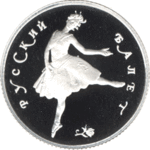 | ||||||||
| Series: Russian Ballet (50 rubles) | |||||||||
| Date | Catalogue # | Value | Grading | Purity | Total weight, g | Platinum contents, at least, g | Diameter, mm | Thickness, mm | # pcs. |
| 19 April 1993 | 5316-0002 | 50 rubles | Proof | 999/1000 | 7.88 (± 0.09) | 7.78 | 20.0 (−0.15) | 1.60 (± 0.15) | 750 |
| Obverse: center – the emblem of the Bank of Russia (two-headed eagle designed by I. Bilibin), bottom – symbol, purity and weight of platinum, "BANK OF RUSSIA"
Reverse: a dancing ballerina, around it: "RUSSIAN BALLET" Design: A.V. Baklanov Mint: Leningrad Mint (LMD) 134 indents on the rim.[38] |
 | ||||||||
| Series: Russian Ballet (150 rubles) | |||||||||
| Date | Catalogue # | Value | Grading | Purity | Total weight, g | Platinum contents, at least, g | Diameter, mm | Thickness, mm | # pcs. |
| 19 April 1993 | 5318-0002 | 150 rubles | Proof | 999/1000 | 15.67 (± 0.11) | 15.55 | 22.60 (−0.25) | 1.5 (± 0.2) | 750 |
| Obverse: center – the emblem of the Bank of Russia (two-headed eagle designed by I. Bilibin), bottom – symbol, purity and weight of platinum, "BANK OF RUSSIA"
Reverse: a dancing ballerina, around it: "RUSSIAN BALLET" Design: A.V. Baklanov Mint: Leningrad Mint (LMD) 240 indents on the rim.[39] |
 | ||||||||
| Geographical Series: The first Russian voyage around the world. English Embankment in St. Petersburg | |||||||||
| Date | Catalogue # | Value | Grading | Purity | Total weight, g | Platinum contents, at least, g | Diameter, mm | Thickness, mm | # pcs. |
| 28 April 1993 | 5318-0003 | 150 rubles | Proof | 999/1000 | 15.67 (± 0.11) | 15.55 | 28.60 (−0.25) | 1.5 (± 0.2) | 2500 |
| Obverse: center – the emblem of the Bank of Russia (two-headed eagle designed by I. Bilibin), bottom – symbol, purity and weight of platinum, "BANK OF RUSSIA"
Reverse: ships Nadezhda and Neva and two boats. Background – houses of Russia's State Chancellor Count N.P. Rumyantsev in St. Petersburg on the English Embankment of the Neva River. Around it: "The first Russian voyage around the world 1803 • 1806" "English Embankment" Design: A.V. Baklanov Mint: Leningrad Mint (LMD). 240 indents on the rim.[40] |
 | ||||||||
| Historical Series: Russia's Contribution to World Culture. I. Stravinsky | |||||||||
| Date | Catalogue # | Value | Grading | Purity | Total weight, g | Platinum contents, at least, g | Diameter, mm | Thickness, mm | # pcs. |
| 13 December 1993 | 5318-0004 | 150 rubles | Proof | 999/1000 | 15.67 (± 0.11) | 15.55 | 28.60 (−0.25) | 1.5 (± 0.2) | 3000 |
| Obverse: center – the emblem of the Bank of Russia (two-headed eagle designed by I. Bilibin), bottom – symbol, purity and weight of platinum, "BANK OF RUSSIA"
Reverse: the image of Igor Stravinsky, background – a scene from the ballet "Petrushka", left – a lyre and a laurel branch, around: "RUSSIA AND WORLD CULTURE", "I. Stravinsky" Design: A.V. Baklanov Mint: Leningrad Mint (LMD) 240 indents on the rim.[41] |
 | ||||||||
| Series: Russian Ballet (25 rubles, 1994) | |||||||||
| Date | Catalogue # | Value | Grading | Purity | Total weight, g | Platinum contents, at least, g | Diameter, mm | Thickness, mm | # pcs. |
| 07.06.1994 | 5315-0002 | 25 rubles | Proof | 999/1000 | 3.198 (± 0.08) | 3.11 | 16.0 (−0.1) | 1.00 (± 0.15) | 900 |
| Obverse: two-headed eagle (designed by I. Bilibin), bottom – symbol, purity and weight of platinum, "BANK OF RUSSIA"
Reverse: a dancing ballerina, around it: "RUSSIAN BALLET" Design: A.V. Baklanov Mint: Leningrad Mint (LMD) 111 indents on the rim.[42] |
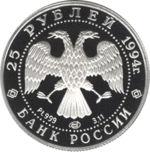 | ||||||||
| Series: Russian Ballet (50 rubles, 1994) | |||||||||
| Date | Catalogue # | Value | Grading | Purity | Total weight, g | Platinum contents, at least, g | Diameter, mm | Thickness, mm | # pcs. |
| 07.06.1994 | 5316-0003 | 50 rubles | Proof | 999/1000 | 7.88 (± 0.09) | 7.78 | 20.0 (−0.15) | 1.60 (± 0.15) | 900 |
| Obverse: two-headed eagle (designed by I. Bilibin), bottom – symbol, purity and weight of platinum, "BANK OF RUSSIA"
Reverse: a dancing ballerina, around it: "RUSSIAN BALLET" Design: A.V. Baklanov Mint: Leningrad Mint (LMD) 134 indents on the rim.[43] |
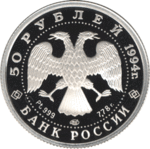 | ||||||||
| Series: Russian Ballet (150 rubles, 1994) | |||||||||
| Date | Catalogue # | Value | Grading | Purity | Total weight, g | Platinum contents, at least, g | Diameter, mm | Thickness, mm | # pcs. |
| 07.06.1994 | 5318-0005 | 150 rubles | Proof | 999/1000 | 15.67 (± 0.11) | 15.55 | 28.6 (−0.25) | 1.5 (± 0.2) | 900 |
| Obverse: two-headed eagle (designed by I. Bilibin), bottom – symbol, purity and weight of platinum, "BANK OF RUSSIA"
Reverse: a dancing ballerina, around it: "RUSSIAN BALLET" Design: A.V. Baklanov Mint: Leningrad Mint (LMD). 240 indents on the rim.[44] |
 | ||||||||
| Geographical Series: First Russian Antarctic Expedition | |||||||||
| Date | Catalogue # | Value | Grading | Purity | Total weight, g | Platinum contents, at least, g | Diameter, mm | Thickness, mm | # pcs. |
| 06.09.1994 | 5318-0006 | 150 rubles | Proof | 999/1000 | 15.67 (± 0.11) | 15.55 | 28.6 (−0.25) | 1.5 (± 0.2) | 4000 |
| Obverse: two-headed eagle (designed by I. Bilibin), bottom – symbol, purity and weight of platinum, "BANK OF RUSSIA"
Reverse: ships Vostok and Mirny, under them – a boat with rowers, penguins on an ice floe, around: "FIRST RUSSIAN ANTARCTIC EXPEDITION 1819–1821", "in Antarctic waters" Design: A.V. Baklanov Mint: Leningrad Mint (LMD) 240 indents on the rim.[45] |
 | ||||||||
| Historical Series: Russia's Contribution to World Culture. Mikhail Vrubel | |||||||||
| Date | Catalogue # | Value | Grading | Purity | Total weight, g | Platinum contents, at least, g | Diameter, mm | Thickness, mm | # pcs. |
| 17 November 1994 | 5318-0007 | 150 rubles | Proof | 999/1000 | 15.67 (± 0.11) | 15.55 | 28.6 (−0.25) | 1.5 (± 0.2) | 3000 |
| Obverse: two-headed eagle (designed by I. Bilibin), bottom – symbol, purity and weight of platinum, "BANK OF RUSSIA"
Reverse: self-portrait of Mikhail Vrubel, below – a palette and brushes, to the right – a fragment of his painting Demon Seated in a Garden, around: "RUSSIA AND WORLD CULTURE", "M. Vrubel" Design: A.V. Baklanov Mint: Leningrad Mint (LMD). 240 indents on the rim.[46] |
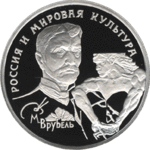 | ||||||||
| Series: Russian Ballet. Sleeping Beauty (25 rubles) | |||||||||
| Date | Catalogue # | Value | Grading | Purity | Total weight, g | Platinum contents, at least, g | Diameter, mm | Thickness, mm | # pcs. |
| 16 June 1995 | 5315-0003 | 25 rubles | Proof | 999/1000 | 3.198 (± 0.08) | 3.11 | 16.0 (−0.1) | 1.00 (± 0.15) | 900 |
| Obverse: center – the emblem of the Bank of Russia (two-headed eagle designed by I. Bilibin), bottom – symbol, purity and weight of platinum, "BANK OF RUSSIA"
Reverse: in the center – a dancer, left to right in a circle – the inscription: "Sleeping Beauty". Design: A.V. Baklanov Mint: Saint Petersburg Mint (LMD) 111 indents on the rim.[47] |
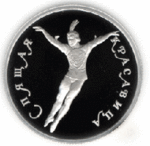 | ||||||||
| Series: Russian Ballet. Sleeping Beauty (50 rubles) | |||||||||
| Date | Catalogue # | Value | Grading | Purity | Total weight, g | Platinum contents, at least, g | Diameter, mm | Thickness, mm | # pcs. |
| 16 June 1995 | 5316-0004 | 50 rubles | Proof | 999/1000 | 7.88 (± 0.09) | 7.78 | 20.0 (−0.15) | 1.60 (± 0.15) | 900 |
| Obverse: center – the emblem of the Bank of Russia (two-headed eagle designed by I. Bilibin), bottom – symbol, purity and weight of platinum, "BANK OF RUSSIA"
Reverse: a dancer, around him: "Sleeping Beauty" Design: A.V. Baklanov Mint: Saint Petersburg Mint (LMD) 134 indents on the rim.[48] |
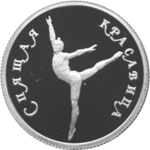 | ||||||||
| Series: Russian Ballet. Sleeping Beauty (150 rubles) | |||||||||
| Date | Catalogue # | Value | Grading | Purity | Total weight, g | Platinum contents, at least, g | Diameter, mm | Thickness, mm | # pcs. |
| 16 June 1995 | 5318-0008 | 150 rubles | Proof | 999/1000 | 15.67 (± 0.11) | 15.55 | 22.60 (−0.25) | 1.5 (± 0.2) | 900 |
| Obverse: center – the emblem of the Bank of Russia (two-headed eagle designed by I. Bilibin), bottom – symbol, purity and weight of platinum, "BANK OF RUSSIA"
Reverse: a dancer, around him: "Sleeping Beauty" Design: A.V. Baklanov Mint: Saint Petersburg Mint (LMD) 134 indents on the rim.[49] |
 | ||||||||
| Historical Series: 1000 years of Russia. Alexander Nevsky | |||||||||
| Date | Catalogue # | Value | Grading | Purity | Total weight, g | Platinum contents, at least, g | Diameter, mm | Thickness, mm | # pcs. |
| 28 December 1995 | 5318-0009 | 150 rubles | Proof | 999/1000 | 15.55 (± 0.09) | 15.5 | 28.6 (−0.25) | 1.5 (± 0.2) | 3000 |
| Obverse: center – the emblem of the Bank of Russia (two-headed eagle designed by I. Bilibin), bottom – symbol, purity and weight of platinum, "BANK OF RUSSIA"
Reverse: a fight between four Russian soldiers and a Swedish knight, around: "1000 YEARS OF RUSSIA · Alexander Nevsky", "BATTLE AT THE RIVER NEVA 1240" Design: A.V. Baklanov Mint: Saint Petersburg Mint (LMD). 240 indents on the rim.[50] |
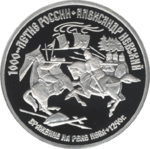 | ||||||||
Platinum coin series
Several other countries have issued platinum coins, but only as bullion coins. These coins are considered serial because the design of the reverse and obverse is the same or similar for all the coins of a given year. In addition to similarities in design, these coins are combined in the series because they are issued annually for a period of time. For example, the Platinum Panda was produced from 1987 to 2005, and the American Platinum Eagle from 1997 to 2008.
| Country | Name | Release year |
|---|---|---|
| | American Platinum Eagle | 1997–Present |
| | Canadian Platinum Maple Leaf | 1988–1999, 2002 |
| | Platinum Noble | 1983–1989 |
| | Platinum Cat | ? |
| | Platinum Koala | 1988–2010 |
| | Platinum Panda | 1988–2005 |
American Platinum Eagle
The American Platinum Eagle is the official platinum bullion coin of the United States. These coins are made of 0.9995 pure platinum with face values of 10, 25, 50 and 100 dollars and were first released by the United States Mint in 1997. The design of coins of different values is almost the same, except for some numerical values. The 2009 minting of Platinum Eagles was uncertain due to rising metal prices;[51] however, the issue of 8,000 one-ounce coins was announced in October. The price was set at $1,792, and the entire edition was sold out within a week.[52]
| Reverse $100 | year | Weight, oz | Weight, g | Diameter, mm | Thickness, mm | Grading | Circulation |
|---|---|---|---|---|---|---|---|
 | 1997 | 1 | 31.120 | 32.70 | 2.39 | BU | 56000 |
| 1997 | 1 | 31.120 | 32.70 | 2.39 | Proof | 16000 | |
| 1997 | 1/2 | 15.560 | 27.0 | 1.75 | BU | 20500 | |
| 1997 | 1/2 | 15.560 | 27.0 | 1.75 | Proof | 14640 | |
| 1997 | 1/4 | 7.780 | 22.0 | 1.32 | BU | 27100 | |
| 1997 | 1/4 | 7.780 | 22.0 | 1.32 | Proof | 18730 | |
| 1997 | 1/10 | 3.112 | 16.5 | 0.95 | BU | 70250 | |
| 1997 | 1/10 | 3.112 | 16.5 | 0.95 | Proof | 37270 | |
 | 1998 | 1 | 31.120 | 32.70 | 2.39 | BU | 133002 |
| 1998 | 1 | 31.120 | 32.70 | 2.39 | Proof | 26050 | |
| 1998 | 1/2 | 15.560 | 27.0 | 1.75 | BU | 32419 | |
| 1998 | 1/2 | 15.560 | 27.0 | 1.75 | Proof | 13920 | |
| 1998 | 1/4 | 7.780 | 22.0 | 1.32 | BU | 38887 | |
| 1998 | 1/4 | 7.780 | 22.0 | 1.32 | Proof | 14203 | |
| 1998 | 1/10 | 3.112 | 16.5 | 0.95 | BU | 39525 | |
| 1998 | 1/10 | 3.112 | 16.5 | 0.95 | Proof | 19920 | |
 | 1999 | 1 | 31.120 | 32.70 | 2.39 | BU | 56707 |
| 1999 | 1 | 31.120 | 32.70 | 2.39 | Proof | 12355 | |
| 1999 | 1/2 | 15.560 | 27.0 | 1.75 | BU | 32309 | |
| 1999 | 1/2 | 15.560 | 27.0 | 1.75 | Proof | 11100 | |
| 1999 | 1/4 | 7.780 | 22.0 | 1.32 | BU | 39734 | |
| 1999 | 1/4 | 7.780 | 22.0 | 1.32 | Proof | 13524 | |
| 1999 | 1/10 | 3.112 | 16.5 | 0.95 | BU | 55955 | |
| 1999 | 1/10 | 3.112 | 16.5 | 0.95 | Proof | 19125 | |
 | 2000 | 1 | 31.120 | 32.70 | 2.39 | BU | 10003 |
| 2000 | 1 | 31.120 | 32.70 | 2.39 | Proof | 12400 | |
| 2000 | 1/2 | 15.560 | 27.0 | 1.75 | BU | 18892 | |
| 2000 | 1/2 | 15.560 | 27.0 | 1.75 | Proof | 11000 | |
| 2000 | 1/4 | 7.780 | 22.0 | 1.32 | BU | 20054 | |
| 2000 | 1/4 | 7.780 | 22.0 | 1.32 | Proof | 11900 | |
| 2000 | 1/10 | 3.112 | 16.5 | 0.95 | BU | 34027 | |
| 2000 | 1/10 | 3.112 | 16.5 | 0.95 | Proof | 15600 | |
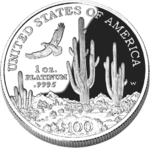 | 2001 | 1 | 31.120 | 32.70 | 2.39 | BU | 14070 |
| 2001 | 1 | 31.120 | 32.70 | 2.39 | Proof | 14000 | |
| 2001 | 1/2 | 15.560 | 27.0 | 1.75 | BU | 12815 | |
| 2001 | 1/2 | 15.560 | 27.0 | 1.75 | Proof | 13000 | |
| 2001 | 1/4 | 7.780 | 22.0 | 1.32 | BU | 21815 | |
| 2001 | 1/4 | 7.780 | 22.0 | 1.32 | Proof | 15000 | |
| 2001 | 1/10 | 3.112 | 16.5 | 0.95 | BU | 52017 | |
| 2001 | 1/10 | 3.112 | 16.5 | 0.95 | Proof | 25000 | |
 | 2002 | 1 | 31.120 | 32.70 | 2.39 | BU | 11502 |
| 2002 | 1 | 31.120 | 32.70 | 2.39 | Proof | 9835 | |
| 2002 | 1/2 | 15.560 | 27.0 | 1.75 | BU | 24005 | |
| 2002 | 1/2 | 15.560 | 27.0 | 1.75 | Proof | 8775 | |
| 2002 | 1/4 | 7.780 | 22.0 | 1.32 | BU | 27405 | |
| 2002 | 1/4 | 7.780 | 22.0 | 1.32 | Proof | 9285 | |
| 2002 | 1/10 | 3.112 | 16.5 | 0.95 | BU | 23005 | |
| 2002 | 1/10 | 3.112 | 16.5 | 0.95 | Proof | 12365 | |
 | 2003 | 1 | 31.120 | 32.70 | 2.39 | BU | 8007 |
| 2003 | 1 | 31.120 | 32.70 | 2.39 | Proof | 14000 | |
| 2003 | 1/2 | 15.560 | 27.0 | 1.75 | BU | 17409 | |
| 2003 | 1/2 | 15.560 | 27.0 | 1.75 | Proof | 13000 | |
| 2003 | 1/4 | 7.780 | 22.0 | 1.32 | BU | 25207 | |
| 2003 | 1/4 | 7.780 | 22.0 | 1.32 | Proof | 15000 | |
| 2003 | 1/10 | 3.112 | 16.5 | 0.95 | BU | 22007 | |
| 2003 | 1/10 | 3.112 | 16.5 | 0.95 | Proof | 20000 | |
 | 2004 | 1 | 31.120 | 32.70 | 2.39 | BU | 7009 |
| 2004 | 1 | 31.120 | 32.70 | 2.39 | Proof | 14000 | |
| 2004 | 1/2 | 15.560 | 27.0 | 1.75 | BU | 13236 | |
| 2004 | 1/2 | 15.560 | 27.0 | 1.75 | Proof | 13000 | |
| 2004 | 1/4 | 7.780 | 22.0 | 1.32 | BU | 18010 | |
| 2004 | 1/4 | 7.780 | 22.0 | 1.32 | Proof | 15000 | |
| 2004 | 1/10 | 3.112 | 16.5 | 0.95 | BU | 15010 | |
| 2004 | 1/10 | 3.112 | 16.5 | 0.95 | Proof | 20000 | |
 | 2005 | 1 | 31.120 | 32.70 | 2.39 | BU | 6310 |
| 2005 | 1 | 31.120 | 32.70 | 2.39 | Proof | 14000 | |
| 2005 | 1/2 | 15.560 | 27.0 | 1.75 | BU | 9013 | |
| 2005 | 1/2 | 15.560 | 27.0 | 1.75 | Proof | 13000 | |
| 2005 | 1/4 | 7.780 | 22.0 | 1.32 | BU | 12013 | |
| 2005 | 1/4 | 7.780 | 22.0 | 1.32 | Proof | 15000 | |
| 2005 | 1/10 | 3.112 | 16.5 | 0.95 | BU | 14013 | |
| 2005 | 1/10 | 3.112 | 16.5 | 0.95 | Proof | 20000 | |
 | 2006 | 1 | 31.120 | 32.70 | 2.39 | BU | 6000 |
| 2006 | 1 | 31.120 | 32.70 | 2.39 | Proof | ? | |
| 2006 | 1/2 | 15.560 | 27.0 | 1.75 | BU | 9602 | |
| 2006 | 1/2 | 15.560 | 27.0 | 1.75 | Proof | ? | |
| 2006 | 1/4 | 7.780 | 22.0 | 1.32 | BU | 12001 | |
| 2006 | 1/4 | 7.780 | 22.0 | 1.32 | Proof | ? | |
| 2006 | 1/10 | 3.112 | 16.5 | 0.95 | BU | 11001 | |
| 2006 | 1/10 | 3.112 | 16.5 | 0.95 | Proof | ? | |
 | 2007 | 1 | 31.120 | 32.70 | 2.39 | BU | 7202 |
| 2007 | 1 | 31.120 | 32.70 | 2.39 | Proof | ? | |
| 2007 | 1/2 | 15.560 | 27.0 | 1.75 | BU | 7001 | |
| 2007 | 1/2 | 15.560 | 27.0 | 1.75 | Proof | ? | |
| 2007 | 1/4 | 7.780 | 22.0 | 1.32 | BU | 8402 | |
| 2007 | 1/4 | 7.780 | 22.0 | 1.32 | Proof | ? | |
| 2007 | 1/10 | 3.112 | 16.5 | 0.95 | BU | 13003 | |
| 2007 | 1/10 | 3.112 | 16.5 | 0.95 | Proof | ? | |
 | 2008 | 1 | 31.120 | 32.70 | 2.39 | BU | ? |
| 2008 | 1 | 31.120 | 32.70 | 2.39 | Proof | ? | |
| 2008 | 1/2 | 15.560 | 27.0 | 1.75 | BU | ? | |
| 2008 | 1/2 | 15.560 | 27.0 | 1.75 | Proof | ? | |
| 2008 | 1/4 | 7.780 | 22.0 | 1.32 | BU | ? | |
| 2008 | 1/4 | 7.780 | 22.0 | 1.32 | Proof | ? | |
| 2008 | 1/10 | 3.112 | 16.5 | 0.95 | BU | ? | |
| 2008 | 1/10 | 3.112 | 16.5 | 0.95 | Proof | ? | |
 | 2009 | 1 | 31.120 | 32.70 | 2.39 | Proof | 8000 [52] |
 | 2010 | 1 | 31.120 | 32.70 | 2.39 | Proof | 10000 [54] |
In 2009, the U.S. Mint announced a six-year plan to issue a new series of platinum coins, which will be devoted to the basic principles of democracy set forth in the preamble of the U.S. Constitution. The yearly topics will be "To Form a More Perfect Union" (2009), "To Establish Justice" (2010), "To Insure Domestic Tranquility" (2011), "To Provide for the Common Defense" (2012), "To Promote the General Welfare" (2013) and "To Secure the Blessings of Liberty to Ourselves and our Posterity" (2014).[55] The 2009 and 2010 issues were quickly sold out.[56]
Platinum Maple Leaf
Canada produced platinum coins from 1988 to 1999,[57] with a 10th anniversary edition in 1989,[58] and a series with a hologram on the reverse in 2002. Their weight ranges from 1/20 to 1 ounce (1.5 to 31.1 g).[59]
The first issue of the Maple Leaf coins with the face value of 50, 20, 10, and 5 Canadian dollars was announced on 11 July 1988,[60] and minting began on 21 September of the same year.[61] The official selling started on 17 November 1988 in six cities,[62] and the total volume of 64,200 ounces was sold during the first six weeks.[63][64]
On 29 July 1993, the Royal Canadian Mint started production of 1/20 oz, $1 coins,[63][65] and on 9 September 1994 launched a 1/15 oz variety.[66][67] However, the production of the 1/15 oz coins was discontinued in January 1996.[63][68] The coins contain an image of maple leaves (the national symbol of Canada) and a portrait of Queen Elizabeth II. The 1 ounce coins are sold in batches of 10 pieces packed in plastic tubes.[69]
| Regular editions, sold at prices close to the price of the metal | ||||
|---|---|---|---|---|
| Value | Weight, oz | Weight, g | Year | Note |
| $1 | 1/20 | 1.555 | 1993–1999 | |
| $2 | 1/15 | 2.07 | 1994 | |
| $5 | 1/10 | 3.131 | 1988–1999 | |
| $10 | 1/4 | 7.197 | 1988–1999 | |
| $20 | 1/2 | 15.575 | 1988–1999 | |
| $50 | 1 | 31.15 | 1988–1999 | |
| Special collectible editions, priced much higher than the price of the metal | ||||
| Value | Weight, oz | Weight, g | Year | Note |
| $5 | 1/10 | 3.131 | 1989 | 10th anniversary issue |
| $10 | 1/4 | 7.797 | 1989 | 10th anniversary issue |
| $20 | 1/2 | 15.575 | 1989 | 10th anniversary issue |
| $50 | 1 | 31.15 | 1989 | 10th anniversary issue |
| $1 | 1/20 | 1.555 | 2002 | hologram |
| $2 | 1/15 | 2.07 | 2002 | hologram |
| $5 | 1/10 | 3.131 | 2002 | hologram |
| $10 | 1/4 | 7.197 | 2002 | hologram |
| $20 | 1/2 | 15.575 | 2002 | hologram |
| $50 | 1 | 31.15 | 2002 | hologram |
Platinum Koala
The Platinum Koala is the most famous series of Australian platinum coins. On 18 June 1987, the Australian Government approved the minting of platinum and silver coins, and accepted them as legal tender. This decision was made based on the success of gold coins issued a year earlier. The minting of the "Platinum Koala" began in September 1988 in Perth. For marketing purposes, 2 ounce, 10 ounce, and 1 kilogram coins of silver, gold and platinum were introduced in 1991; the 1 kg coins were the world's heaviest bullion coins at the time.[70]
The obverse, designed by Raphael Maklouf for most issues, depicts Queen Elizabeth II, and the reverse contains an image of a koala. The initials of the reverse face designer James Brown are present on most coins. The annual series contain coins weighing from 1/20 ounce to 1 kilogram.[71]
| Weight | 1/20 oz | 1/10 oz | 1/4 oz | 1/2 oz | 1 oz | 2 oz | 10 oz | 1 kg |
|---|---|---|---|---|---|---|---|---|
| Face value, A$[72] | 5 | 10 | 25 | 50 | 100 | 200 | 1,000 | 3,000 |
| Thickness, mm[73] | 1.32 | 1.40 | 1.90 | 2.03 | 2.7 | 3.8[74] | 7.9[75] | 13.9[76] |
| Diameter, mm [73] | 14.1 | 16.1 | 20.1 | 25.1 | 32.1 | 40.60 | 60.30 | 75.30 |
The Platinum Koala never reached the popularity of the American Platinum Eagle, mostly because it has not been advertised in the US.[77] Like most investment platinum coins, Platinum Koalas are sealed in a protective plastic case. The coins are sold at prices that reflect the current price of platinum, and not at the face value printed on the coin. Since November 1986, the Perth Mint has used more than 18 tonnes of platinum for minting. About 85% of the coins were sold abroad making the Gold Corporation (owner of the Mint) one of Australia's top 30 export earners.[78]
Platinum Panda
The Platinum Panda is a series of platinum coins of China produced from 1987 to 2005.[lower-alpha 4]</ref> The series is named after the image of giant panda printed on the reverse of all coins. The People's Bank of China minted 8,300 one-ounce Platinum Panda coins between 1987 and 1990 with a face value of 100 yuan. Additionally, 5,450 ounces of platinum were used for coins of smaller denominations in the 1990s through the first decade of the 21st century.[79] Minting was discontinued in 2005, mostly due to the increasing price of platinum; while in 1990 the price was about US $490/oz, it crossed the $2,000 mark in the summer of 2008.[80] All Platinum Pandas, except for coins of 2004–2005, are very rare and their availability can not be judged from the minted volumes.[79] This is partly because some coins had been remelted.
| Year | Value, Yuan | Diameter, mm |
Weight, g |
# pcs. |
|---|---|---|---|---|
| 1987 | 100 | 32 | 31.1 | 2000 |
| 1988 | 100 | 32 | 31.1 | 2000 |
| 1989 | 100 | 32 | 31.1 | 3000 |
| 1990 | 100 | 32 | 31.1 | 1300 |
| 1990 | 50 | 27 | 15.55 | 2500 |
| 1990 | 25 | 22 | 7.8 | 3500 |
| 1990 | 10 | 18 | 3.1 | 4500 |
| 1993 | 10 | 18 | 3.1 | 2500 |
| 1993 | 5 | 14 | 1.55 | 2500 |
| 1994 | 10 | 18 | 3.1 | 5000 |
| 1995 | 10 | 18 | 3.1 | 5000 |
| 1995 | 5 | 14 | 1.55 | 10000 |
| 1996 | 10 | 18 | 3.1 | 2500 |
| 1996 | 5 | 14 | 1.55 | 5000 |
| 1997 | 10 | 18 | 3.1 | 2500 |
| 1997 | 5 | 14 | 1.55 | 5000 |
| 2002[lower-alpha 5] | 100 | 18 | 3.1 | 20000 |
| 2003 | 50 | 14 | 1.55 | 50000 |
| 2004 | 50 | 14 | 1.55 | 50000 |
| 2005 | 100 | 18 | 3.1 | 30000 |
Single issues

Many commemorative coins were dedicated to a significant event or anniversary and issued only once. For example, Estonia released a platinum coin in 2008 to honor its 90th anniversary, and Tonga issued 400 platinum coins in 1967 for the coronation of Taufa'ahau Tupou IV.[1] Other countries that have minted commemorative platinum coins include Congo,[81] Panama,[82] South Africa, Portugal and France.[83]
The Estonian issue began on 24 February 2008 – Independence Day – and included silver, gold and platinum coins. The platinum coin was a first for Estonia. Its reverse featured a Barn Swallow – the national symbol of Estonia – and the obverse showed the national coat of arms. The coin had a face value of 100 Estonian kroons, a platinum purity of 999/1000, a weight of 7.775 grams,[84] and a diameter of 18.0 mm.[85] The coin was designed by Tiit Jϋrna and produced by the Mint of Finland with a quantity of 3,000 pieces.[84][86] The opening sale took place in the Hall of Independence at the National Bank, where the independence of Estonia was proclaimed 90 years ago;[84] 349 coins and 176 sets were sold within three and a half hours.[87] The entire issue is now sold out.[88]
Investing in coins and their storage
Platinum coins are a popular investment, and each year the number of such coins sold by Sberbank of Russia increases by 30–50%.[89] Most experts agree that such investments should have a long-term character, as the rise of the platinum price is relatively slow – about 80% over the last 5 years, except for a rapid rise followed by decline in 2008.[80][90] Also, whereas most banks can sell platinum coins, only a few buy them, as this requires evaluation by an experienced professional. For example, only 5% of offices of Sberbank (the major bank of Russia) in the capital city of Moscow redeem precious metal coins.[91] The selling price is also much affected by visible scratches, spots, patina, and other defects introduced by bad handling.[92] For this reason, most bullion coins are sealed in transparent plastic right after removal from the press. They are then stored in a dry room with relative humidity below 80% and at temperatures between 15 to 40 °C.[93] If a coin is removed from its plastic seal, it is recommended not to store it in PVC albums, as PVC molecules gradually break down, releasing organochlorine compounds which produce patina on the coins. These compounds may also form acids by reacting with moisture. Unlike silver, platinum does not corrode.[94] However, as is true for all unprotected coins, platinum coins are prone to contamination which can be caused even by washing with (chlorine-containing) tap water.[93]
See also
Notes
- ↑ Typo in the source. The correct value is 4121073, not 412,073
- ↑ Circulation values differ from source to source
- ↑ Platinum Coins 1988–1991, the USSR issued only with the quality of proof. Circulation in the different cost sources. The figures, which called into question in italics.
- ↑ Images of these coins do not fall under a Wikipedia-compatible license, but can be found at numismatic sites.
- ↑ The 2002 issue is dedicated to the 20th anniversary of the printing of the Chinese Panda Gold Coin.
References
- ↑ 1.0 1.1 N. Kudryashov (2000). "Серебришко, которое платина" [Silver which is platinum]. Nauka i Zhizn (in Russian) 6.
- ↑ "Information about platinum coins". Retrieved 13 November 2009.
- ↑ "From the Grading Room: 1825 Great Britain Pattern Farthing Mule, Struck in Platinum". Retrieved 13 November 2009.
- ↑ 4.0 4.1 А. Portnow. "Platinum tragedy of Russia". Retrieved 4 September 2009.
- ↑ "Платиновые монеты" [Platinum Coins] (in Russian). coinsrussia.ru. Retrieved 11 October 2009.
- ↑ "База данных по памятным и инвестиционным монетам" [Database on Commemorative Coins] (in Russian). The Bank of Russia. Retrieved 11 October 2009.
- ↑ "Platinmünze – Noble" (in German). Retrieved 11 October 2009.
- ↑ "Isle of Man Brilliant Uncirculated Platinum Cats". Retrieved 11 October 2009.
- ↑ "Platinum Bullion, Platinum Coins, & Platinum Bars". Retrieved 29 October 2009.
- ↑ "American Platinum Eagle Coin". Retrieved 29 October 2009.
- ↑ B. B. Uzdennikov (1992). Монеты России [Coins of Russia] (in Russian). Moscow.
- ↑ "Платиновые монеты" [Platinum coins] (in Russian). COINSS.RU. Retrieved 11 September 2009.
- ↑ 13.0 13.1 13.2 13.3 13.4 Mikhail Maksimov (1977). Очерк о золоте [An essay about gold] (in Russian). Moscow: Nedra. p. 83.
- ↑ Jacob Eckfeldt (1842). A manual of gold and silver coins of all nations struck within the past century: showing their history, and legal basis and their actual weight, fineness, and value, chiefly from original and recent assays. Assay Office of the Mint. pp. 109–111.
- ↑ "Таблица удельного веса металлов" [Metal density table] (in Russian). Uralmet. Retrieved 29 September 2009.
- ↑ 16.0 16.1 16.2 16.3 "Платиновые монеты: история, коллекционирование, цены" [Platinum Coins: history, collecting, prices] (in Russian). Ювелирные Известия. Retrieved 29 August 2009.
- ↑ "Платиновые россыпи Российской Империи" [Platinum placers of the Russian Empire] (in Russian). Retrieved 4 September 2009.
- ↑ "История чеканки платиновых монет в России" [History of platinum coins minting in Russia] (in Russian). Retrieved 29 August 2009.
- ↑ N. K. Vysotsky (1923). Platinum and its area of production. Petrograd.
- ↑ 20.0 20.1 Stanisław Shaman. "Олимпийская платина" [Olympic Platinum]. Деньги (Money) (in Russian) 31 (536).
- ↑ 21.0 21.1 "Памятные монеты СССР" [Commemorative coins of the USSR] (in Russian). 16 February 2006. Retrieved 11 September 2009.
- ↑ "Памятные монеты СССР из платины. Серия: XXII Олимпийские игры в Москве, эмблема игр" [Series XXII Olympic Games in Moscow, the games emblem] (in Russian). Archived from the original on 4 November 2005. Retrieved 10 September 2009.
- ↑ "Серия: XXII Олимпийские игры в Москве, дискобол" [Series XXII Olympic Games in Moscow, discus thrower] (in Russian). Archived from the original on 4 November 2005. Retrieved 10 September 2009.
- ↑ "Серия: XXII Олимпийские игры в Москве, античные борцы" [Series: XXII Olympic Games in Moscow, the ancient wrestlers] (in Russian). Archived from the original on 4 November 2005. Retrieved 10 September 2009.
- ↑ "Серия: XXII Олимпийские игры в Москве, античные колесницы" [Series: XXII Olympic Games in Moscow, the ancient chariots] (in Russian). Archived from the original on 4 November 2005. Retrieved 10 September 2009.
- ↑ "Серия: XXII Олимпийские игры в Москве, античные бегуны" [Series: XXII Olympic Games in Moscow, the ancient runners] (in Russian). Archived from the original on 4 November 2005. Retrieved 10 September 2009.
- ↑ "Памятные монеты СССР из платины. Серия: тысячелетие Крещения Руси. Слово о Полку Игореве" [Commemorative coins of the USSR in platinum. Series: Millennium of the Baptism of Rus] (in Russian). Retrieved 11 September 2009.
- ↑ "Памятные монеты СССР из платины. Серия: 500-летие единого русского государства. Cтояние на Угре" [Commemorative coins of the USSR in platinum. Series: 500 years of united Russian state. Standing on the Ugra] (in Russian). Retrieved 11 September 2009.
- ↑ "Памятные монеты СССР из платины. Серия: 500-летие единого русского государства. Полтавская битва" [Commemorative coins of the USSR in platinum. Series: 500 years of united Russian state. Battle of Poltava] (in Russian). Retrieved 11 September 2009.
- ↑ "Памятные монеты СССР из платины. Серия: 250 лет открытия Русской Америки. бот "Святой Гавриил"" [Commemorative coins of the USSR in platinum. Series: 250 years of discovery of Russian America. "St. Gabriel"] (in Russian). Retrieved 11 September 2009.
- ↑ "Памятные монеты СССР из платины. Серия: 500-летие единого русского государства. Отечественная война 1812г" [Commemorative coins of the USSR in platinum. Series: 500 years of united Russian state. War of 1812] (in Russian). Retrieved 11 September 2009.
- ↑ "Памятные монеты СССР из платины. Серия: 250-летие открытия Русской Америки. Иоанн Вениаминов" [Commemorative coins of the USSR in platinum. Series: 250-anniversary of the discovery of Russian America. John Benjamin] (in Russian). Retrieved 11 September 2009.
- ↑ "Ценник на платиновые монеты 1977–1995 г.г.". Retrieved 11 September 2009.
- ↑ "Юбилейные монеты России 1992–2006". Retrieved 2009-08-28.
- ↑ "Серия: Эпоха просвещения. XVIII век. Чесменское сражение" [Chesme battle]. Retrieved 28 August 2009.
- ↑ "Первое участие России в Олимпийских играх" [First participation of Russia in the Olympics]. Retrieved 28 August 2009.
- ↑ "Russian ballet. Commemorative Coins of Russia" (in Russian). Retrieved 28 August 2009.
- ↑ "Russian State Ballet (50 rubles). Commemorative Coins of Russia" (in Russian). Retrieved 28 August 2009.
- ↑ "Russian State Ballet (150 p). Commemorative Coins of Russia" (in Russian). Retrieved 28 August 2009.
- ↑ "English Embankment in St. Petersburg. Commemorative Coins of Russia". Retrieved 28 August 2009.
- ↑ "Stravinsky. Commemorative Coins of Russia". Retrieved 28 August 2009.
- ↑ "Russian ballet. Commemorative Coins of Russia" (in Russian). Retrieved 28 August 2009.
- ↑ "Russian State Ballet (50 rubles). Commemorative Coins of Russia" (in Russian). Retrieved 28 August 2009.
- ↑ "Russian State Ballet (150 p). Commemorative Coins of Russia" (in Russian). Retrieved 28 August 2009.
- ↑ "First Russian Antarctic Expedition. Commemorative Coins of Russia". Retrieved 28 August 2009.
- ↑ "M. Vrubel. Commemorative Coins of Russia". Retrieved 28 August 2009.
- ↑ "The Sleeping Beauty (25 rubles). Commemorative Coins of Russia". Retrieved 28 August 2009.
- ↑ "The Sleeping Beauty (50 rubles). Commemorative Coins of Russia". Retrieved 28 August 2009.
- ↑ "The Sleeping Beauty (150 p). Commemorative Coins of Russia". Retrieved 28 August 2009.
- ↑ "Alexander Nevsky. Commemorative Coins of Russia". Retrieved 28 August 2009.
- ↑ "Where are the 2009 American Platinum Eagles?". 9 August 2009. Retrieved 17 September 2010.
- ↑ 52.0 52.1 "2009 American Platinum Eagle". Retrieved 17 September 2010.
- ↑ "US Platinum Eagle Coins. Mintage of coins". Retrieved 11 October 2009.
- ↑ "2010 Proof Platinum Eagle". American Platinum Eagle Coin Guide. Retrieved 20 October 2010.
- ↑ "New six-year series began in 2009". Retrieved 17 September 2010.
- ↑ "The United States Mint introduced a new six-year platinum coin program". Retrieved 17 September 2010.
- ↑ "Platinum Canadian Maple Leafs at Monex". Retrieved 7 October 2009.
- ↑ 58.0 58.1 "Canadian Maple Leaf Bullion Coins". Retrieved 9 October 2009.
- ↑ "Canadian Platinum Maple Leaves". Retrieved 7 October 2009.
- ↑ Royal Canadian Mint Annual Report – 1988.
- ↑ Canadian Coin News, 18 October 1988, Volume 26, Number 12.
- ↑ Canadian Coin News, 4 April 1989, Volume 26, Number 24.
- ↑ 63.0 63.1 63.2 "Chronology of Canadian Maple Leaf Bullion Coins". Retrieved 7 October 2009.
- ↑ Canadian Business, June 1989, Volume 62, No 6.
- ↑ Canadian Coin News, 31 August 1993, Volume 31, Number 9.
- ↑ Royal Canadian Mint Communique, 9 September 1994.
- ↑ Canadian Coin News, 27 September 1994, Volume 32, Number 11.
- ↑ Canadian Coin News, 30 January 1996, Volume 33, Number 20.
- ↑ "Canadian Platinum Maple Leaf Bullion Coins". Retrieved 7 October 2009.
- ↑ "Perth Mint Coins". Retrieved 7 October 2009.
- ↑ "Australian Koalas". 24carat.co.uk. Retrieved 7 October 2009.
- ↑ "Australian Koala Decimal Platinum Bullion Coins". Retrieved 7 October 2009.
- ↑ 73.0 73.1 "Platinum Koala bullion coins from Australia". Retrieved 7 October 2009.
- ↑ "1998 Two Ounce Platinum $200 Koala on Fallen Log". Retrieved 7 October 2009.
- ↑ "1996 Ten Ounce Platinum $1,000 Koala". Retrieved 7 October 2009.
- ↑ "1997 Kilogram Platinum $3,000 Koala". Retrieved 7 October 2009.
- ↑ "Australian Platinum Koalas Bullion Coins". 7 July 2009. Retrieved 7 October 2009.
- ↑ "The Perth Mint". Retrieved 7 October 2009.
- ↑ 79.0 79.1 "Coins of China. Platinum Panda". Retrieved 12 September 2009.
- ↑ 80.0 80.1 "Platinum and Palladium Charts. London Platinum and Palladium Market (LPPM)". Retrieved 13 September 2010.
- ↑ Bruce, p. 2202
- ↑ Bruce, p. 1618
- ↑ Bruce, p. 834
- ↑ 84.0 84.1 84.2 "Платина республики" (in Russian). 28 February 2009. Retrieved 10 September 2009.
- ↑ "MEENEMÜNDID (Commemorative coins of Estonia)" (in Estonian). Eesti Pank – Bank of Estonia. Retrieved 10 September 2009.
- ↑ "Estonian Bank will present three produced to mark the 90th anniversary of the Republic of Estonia commemorative coins". 19 February 2008. Retrieved 10 September 2009.
- ↑ "Юбилейные монеты принесли Банку Эстонии за три часа 5,7 млн крон" [Commemorative coins have brought to the Bank of Estonia 5.7 million euros within 3 hours] (in Russian). 26 February 2008. Retrieved 10 September 2009.
- ↑ "Sale of banknotes, coins, commemorative sets". Bank of Estonia. Retrieved 10 September 2009.
- ↑ "Какие монеты сегодня в цене" [What coins are valued today] (in Russian). 1 February 2007. Retrieved 5 October 2009.
- ↑ "Инвестиции, инвестирование в монеты. Инвестиционные монеты" [Investment, investing in the coins. Bullion coins] (in Russian). Retrieved 5 October 2009.
- ↑ "Список дополнительных офисов ОСБ г. Москвы, осуществляющих операции по покупке-продаже монет из драгоценных металлов, покупке-продаже слитков из драгоценных металлов, открытию и ведению ОМС" [Branches of Sberbank of Russia in Moscow, performing operations on purchase and sale of precious metal coins] (PDF) (in Russian). Retrieved 6 October 2009.
- ↑ "Снижает ли стоимость монеты неправильное хранение?" (in Russian). Ural Bank of Sberbank of Russia. Retrieved 6 October 2009.
- ↑ 93.0 93.1 "Чистка древних монет" [Cleaning and storing ancient coins] (in Russian). Retrieved 4 October 2009.
- ↑ "Монеты не подлежащая оценке-2" [Coins which are not redeemed] (in Russian). sobirau.ru. Retrieved 4 October 2009.
Bibliography
- Bruce, Colin R. and Michael, Thomas (1991). Standard Catalog of World Coins 1901–2000. ISBN 0-89689-500-9.
- Chester L. Krause, Clifford Mishler. 2004 standard catalog of world coins: 1901–present. ISBN 0-87349-593-4.
